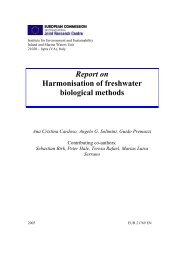Lakes and Watercourses
Lakes and Watercourses
Lakes and Watercourses
You also want an ePaper? Increase the reach of your titles
YUMPU automatically turns print PDFs into web optimized ePapers that Google loves.
Phytoplankton in lakes<br />
Introduction<br />
Planktonic algae (phytoplankton) are an essential part of lake food chains<br />
as a producer of organic matter <strong>and</strong> oxygen, as food for grazing animals<br />
(zooplankton, ciliates, benthic fauna, fish) <strong>and</strong> because they excrete<br />
dissolved organic matter, which also serves as a source of energy <strong>and</strong><br />
nutrition for other microbes.<br />
Algae respond rapidly to changes in water quality because of their<br />
rapid reproduction rate. Changes in the physical <strong>and</strong> chemical status of<br />
the water can be identified after only a week or so in the form of changes<br />
in the balance of species <strong>and</strong> species abundance. Lasting water quality<br />
changes can be discerned in the plankton community from one vegetative<br />
period to another.<br />
Some of the parameters used here to assess phytoplankton represent<br />
fundamental characteristics of plankton assemblages <strong>and</strong> reflect impact<br />
resulting from eutrophication. These include total volume of algae <strong>and</strong><br />
spring-developing diatoms. As well as being an indicator of early effects<br />
of eutrophication, these latter organisms are also an important source of<br />
food for the benthic fauna. Other parameters are associated with harmful<br />
algae, which affect water use in various ways. These include waterblooming<br />
<strong>and</strong> potentially toxin-producing cyanobacteria, as well as<br />
Gonyostomum semen, a slime-producing flagellate.<br />
Assessment parameters relate to different times of the year, depending<br />
on the occurrence of algae <strong>and</strong> their impact on water use:<br />
Parameter<br />
Period<br />
Total phytoplankton volume Seasonal mean during May –<br />
October, <strong>and</strong> August<br />
Chlorophyll-a Seasonal mean during May –<br />
October, <strong>and</strong> August<br />
Diatoms<br />
May or April<br />
Water-blooming cyanobacteria August<br />
Potentially toxin-<br />
August<br />
producing cyanobacteria<br />
Gonyostomum semen<br />
August<br />
51















![Accommodation booking form [PDF]](https://img.yumpu.com/39471785/1/184x260/accommodation-booking-form-pdf.jpg?quality=85)

